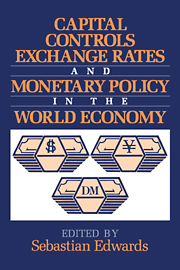Book contents
- Frontmatter
- Contents
- List of contributors
- Introduction
- Part I Monetary policy and stabilization in open economies
- 1 Stabilization and liberalization policies in semi-open economies
- 2 Monetary regime choice for a semi-open country
- 3 Capital account liberalization: bringing policy in line with reality
- Part II Capital mobility and macroeconomic policy in Europe
- Part III Capital controls and macroeconomic policy in the Asia-Pacific region
- Part IV Capital mobility and exchange rates in Latin America
- Index
2 - Monetary regime choice for a semi-open country
Published online by Cambridge University Press: 16 October 2009
- Frontmatter
- Contents
- List of contributors
- Introduction
- Part I Monetary policy and stabilization in open economies
- 1 Stabilization and liberalization policies in semi-open economies
- 2 Monetary regime choice for a semi-open country
- 3 Capital account liberalization: bringing policy in line with reality
- Part II Capital mobility and macroeconomic policy in Europe
- Part III Capital controls and macroeconomic policy in the Asia-Pacific region
- Part IV Capital mobility and exchange rates in Latin America
- Index
Summary
It is natural that a country that industrializes will also begin to liberalize its goods and financial markets. As it seeks to move more fully into the international community of industrialized countries, it will be called upon to allow ever more aspects of its economy to be determined in the marketplace rather than by the government. But it does not follow that every aspect, every macroeconomic variable, should be determined by the marketplace. To focus on a clear example, the exchange rate should not necessarily be determined in the marketplace. Letting the exchange rate float makes more sense if the monetary authorities have decided to fix the money supply (or other nominal quantity). But an equally admissible alternative plan is to fix the exchange rate and let the money supply do the adjusting. One must choose among equally plausible regimes.
To make this point is not to knock down a “straw man.” The U.S. Treasury has in recent years advised newly industrialized countries (NICs) in East Asia that free-market principles necessarily imply free-floating exchange rates. Free-marketeers Milton Friedman and Beryl Sprinkel might agree with that choice, but free-marketeers Robert Mundell and Jack Kemp would not.
Democracy, discipline and deficits
This chapter reviews choices among regimes facing a relatively small, trade-oriented, liberalizing, industrializing country. We begin by observing that the problem is neither interesting nor realistic unless due allowance is made for market failures, such as sticky prices, as well as political failures, such as populist spending binges.
- Type
- Chapter
- Information
- Publisher: Cambridge University PressPrint publication year: 1995
- 9
- Cited by



